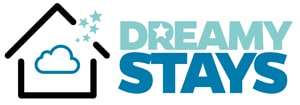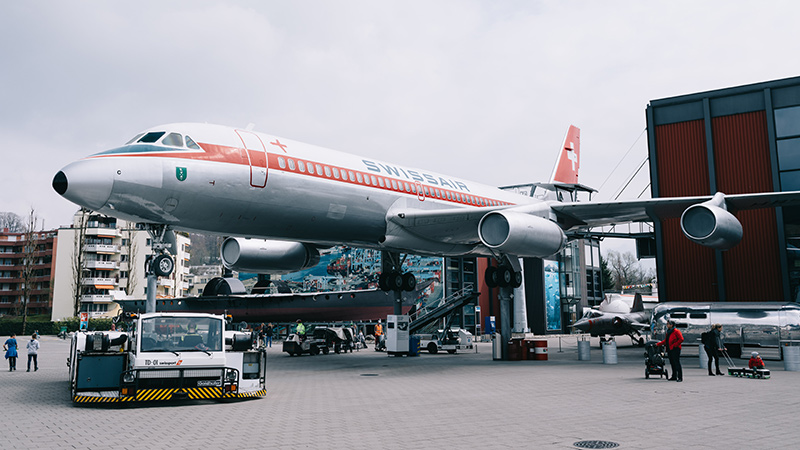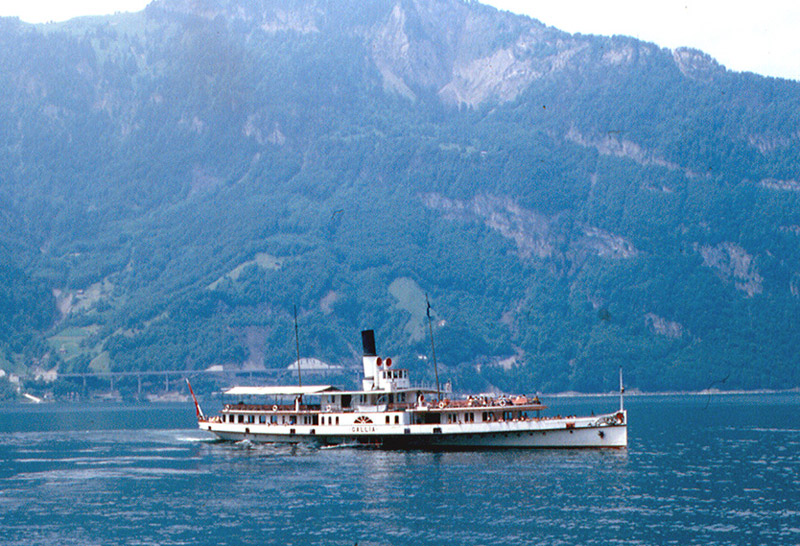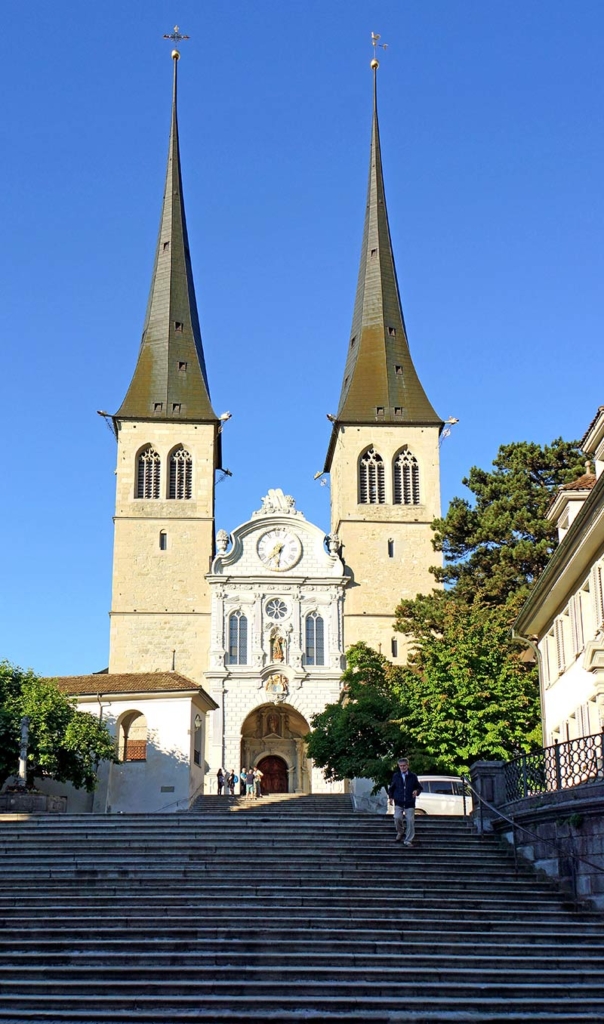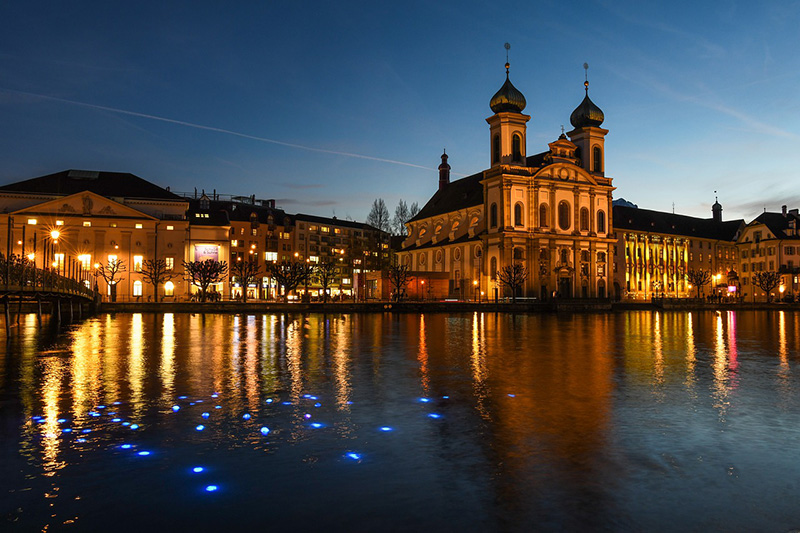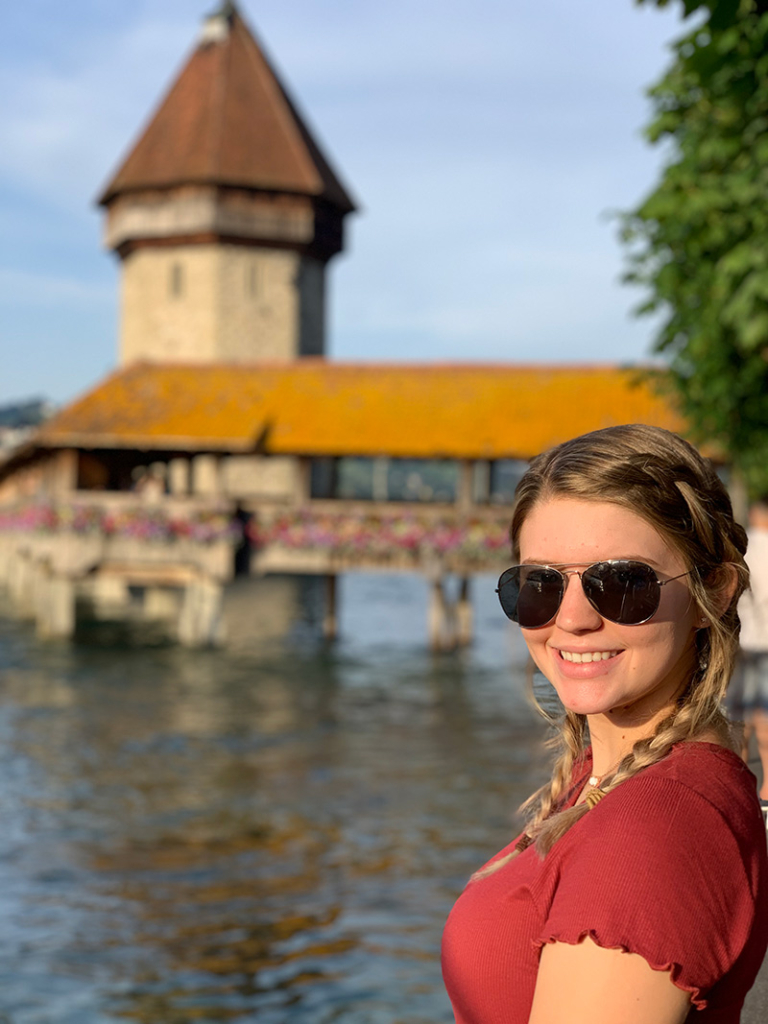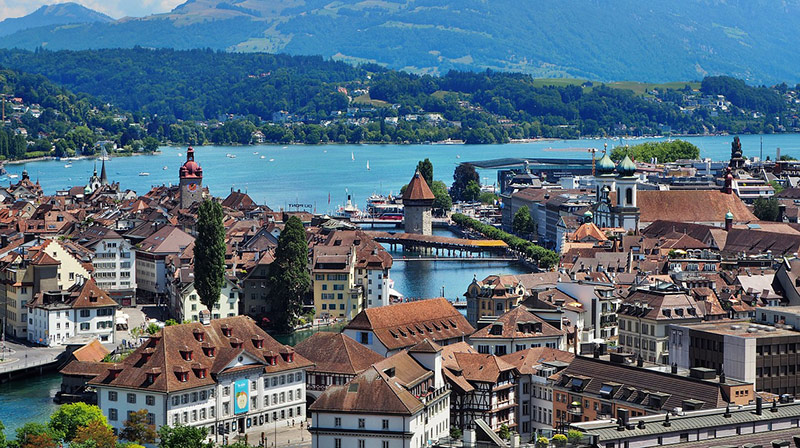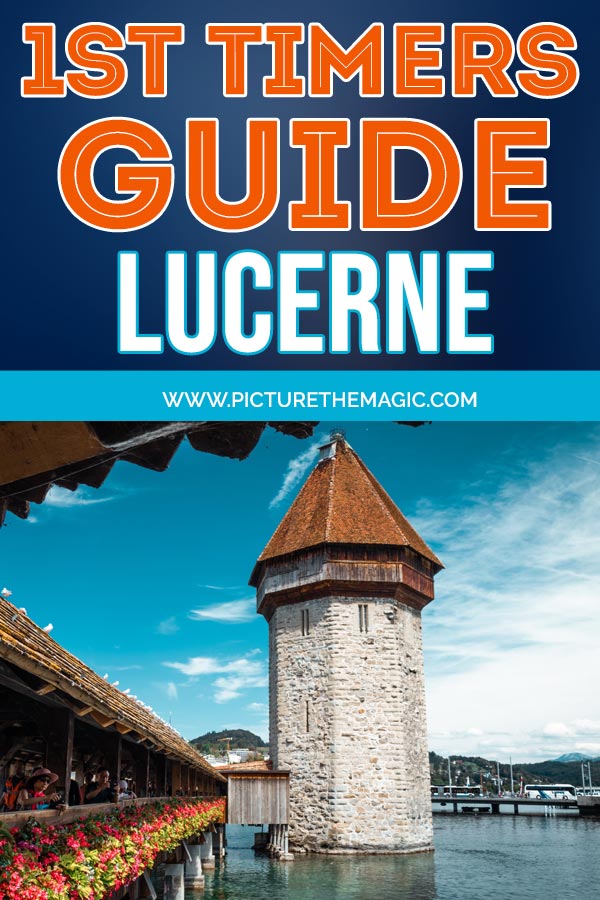This is the ultimate first timer’s travel guide for preparing a vacation to Lucerne, Switzerland.
Pictures don’t do this town justice. When I walked out of the train station, my breath caught at the beauty of the charming waterfront town built hundreds of years ago.
Enjoy the “old town” charm of a medieval city (spelled Luzern by the locals) whose history is delightfully preserved and sustained by its loyal denizens. Each of the churches, castle walls, towers, and bridges has its own story that is ready to be unfolded.
The vibrant turquoise water contrasts nicely with the deep greens of the surrounding foliage and makes the dark brown wood of the middle aged bridges look even more imposing.
Great adventures and great food await you in Lucerne, Switzerland.
Here is everything you need to know so you can plan an incredible trip to Lucerne.
Ultimate Travel Guide to Lucerne, Switzerland
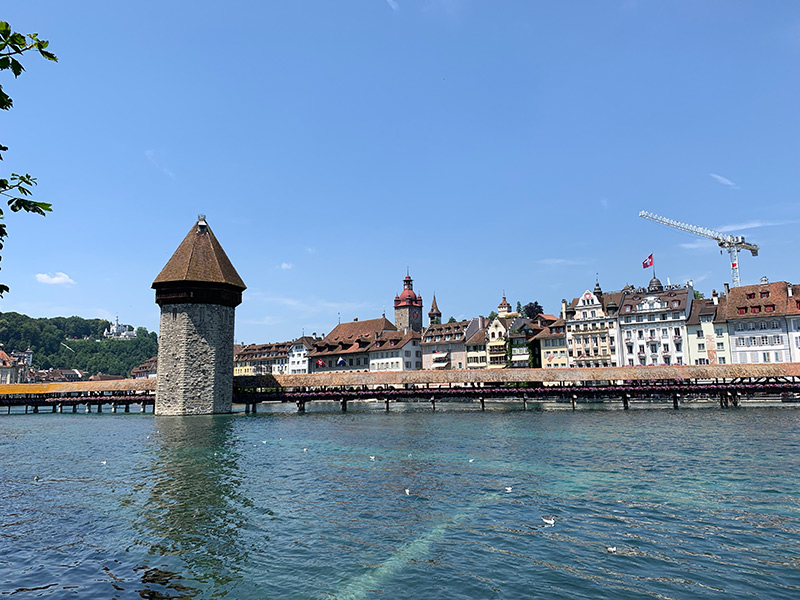
Disclosure: This Lucerne travel guide contains affiliate links. Read full Disclosure Policy.
What This Guide Covers
You can read every single Lucerne tip here (highly recommended) or use the navigation links here to skip to the tips that are most valuable to you.- Top 10 Things to do in Lucerne
- Map of Lucerne
- What to Eat in Lucerne
- Lucerne Weather
- Lucerne Webcams
- Travel Tips When Going to Lucerne
- Facts and History about Lucerne
- Lucerne Trains
- How to Get to Lucerne
- Lucerne Packing List
- Estimated Cost of Lucerne
- Great Photos and Inspiration
Top 10 Things to do in Lucerne
1. Chapel Bridge (Kapellbrücke)
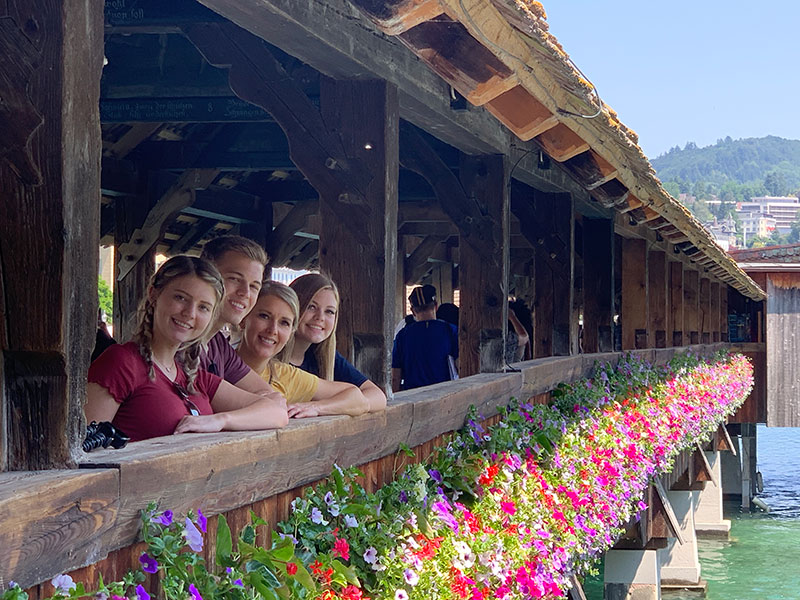
Chapel Bridge may be Switzerland’s most well-known man-made landmark. Built in 1333, it is a charming, flower-lined bridge poised gracefully above the turquoise blue water of the Reuss River. However, the attractive looks of the bridge seems to disguise its original medieval purpose as a defense against waterborne invaders.
The aptly-named Water Tower (because it is a tower in the water, not because it holds water) stands high above the bridge and gives a medieval flavor to the entire scene. It was originally used as a lookout and prison, but today access to the tower is restricted.
St. Peter’s Chapel stands on the north side of the Reuss River and is what gave Chapel Bridge its name. The church that stands there today has been rebuilt, but the original was constructed in the 12th century.
Dozens of striking triangular paintings hang from the inside of the slanted roof of Chapel Bridge. Painted in the 1600s, only a fraction of the original number survive today because of a fire that ravaged the bridge in 1993. Some of the surviving paintings have been restored and are hanging above the bridge walkway.
The paintings recount the rise and development of Lucerne. Along with displaying the growth of the city over time, you can see giants depicted in the artwork. Hundreds of years ago, dark-age settlers mistook mammoth bones found in the area to be the remains of a humanoid giant and memorialize the mythical creature in stories and art.
Link to map.
2. Spreuer Bridge (Spreuerbrucke)
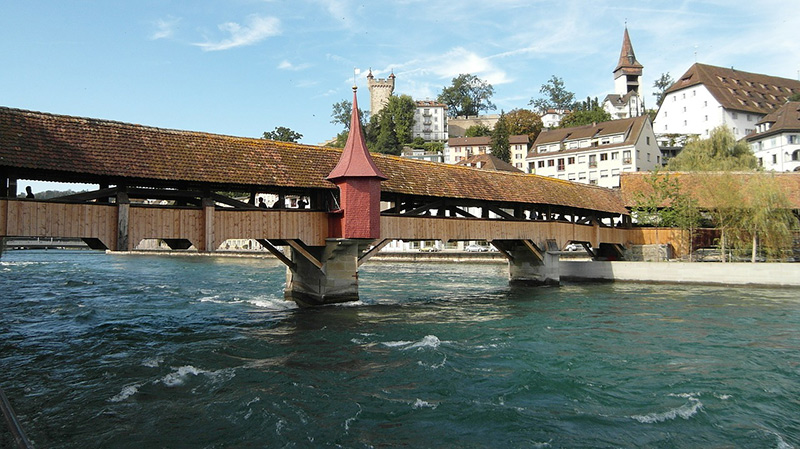
The Spreuer Bridge, originally built around 1400, is Lucerne’s second covered bridge, and like it’s sister Chapel Bridge, triangular paintings adorn the inside of the walkway.
Instead of the historical art found on Chapel Bridge, Spreuer Bridge’s paintings are much darker and portray the “Dance of Death.” In each of the 67 paintings you will find a skeleton that represents death reminding the other subjects in the artwork that no one escapes him.
The official reason these morbid canvases were commissioned is unknown, but it may have been to encourage those walking across the bridge to enjoy life while they still had it.
The name of this bridge comes from the German word spreu which translates to chaff. This bridge was designated as the place where chaff and other waste could be dumped into the Reuss because it would flow down river, away from the city.
Just upstream from the Spreuer Bridge is the Needle Dam, where water is diverted to a hydroelectric power plant and through wooden stakes or “needles” that regulate the level of Lake Lucerne.
While this bridge isn’t as well known as the Chapel Bridge, it is much quieter and there are less tourists here.
TIP: See if you can spot Death in each of the paintings on the antique bridge.
Link to map.
3. The Lion Monument
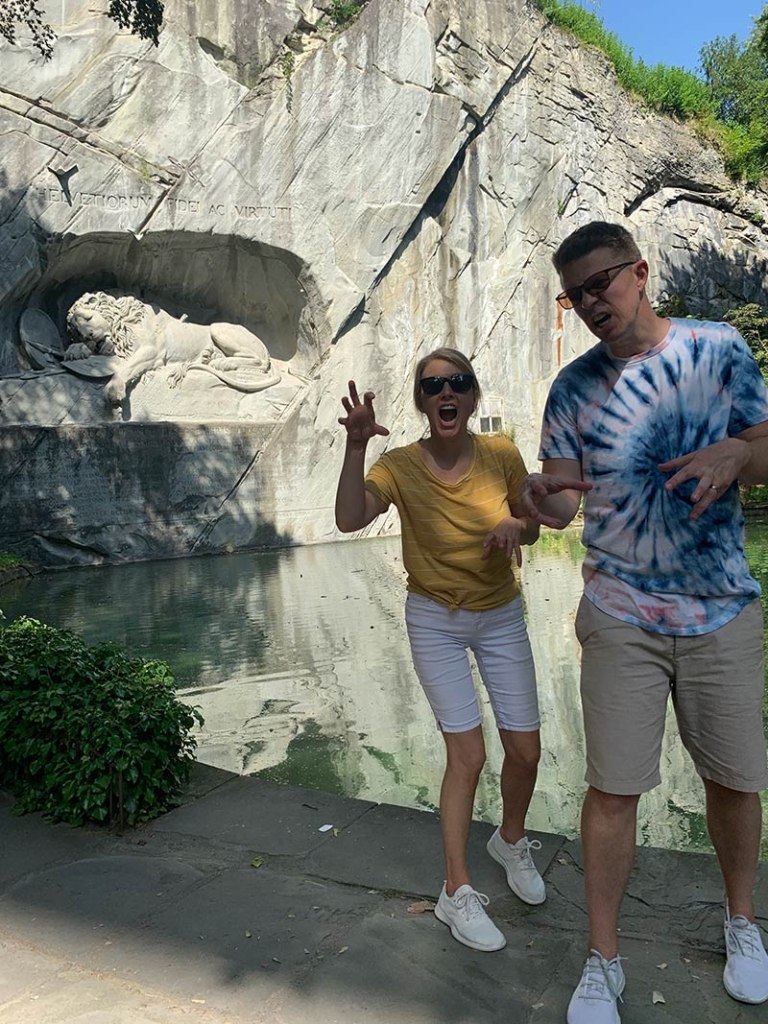
Around the time of the French Revolution, King Louis XVI’s royal guard consisted of hired Swiss mercenaries who were extremely loyal to him. In 1792 when the revolution started, 760 of the Swiss guard died in defense of the king.
This tragedy caused one of the surviving officers who was away from the fighting at the time to want to honor his fallen brothers. After this officer initiated the idea to create this monument, Bertel Thorvaldsen, a Danish sculptor, designed the statue. The Lion Monument was erected in 1821, showing a dying lion with a spearhead in its side.
Above the lion is inscribed “helvetiorum fidei ac virtuti” which means “to the loyalty and bravery of the Swiss.” The shield that the lion is laying on has the fleur-de-lis on it, symbolizing how the lion is dying because it protected the French royal family.
Link to map.
4. Jesuit Church (Jesuitenkirche)
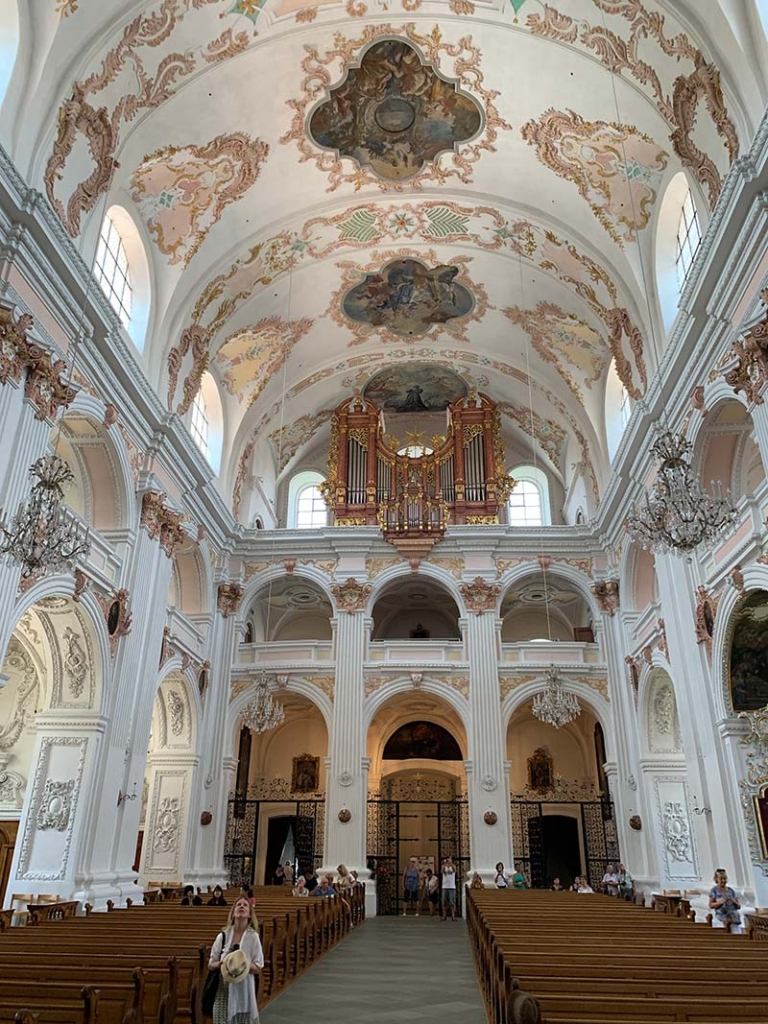
The Jesuit Church in Lucerne holds a commanding position on the Reuss River and towers over other buildings nearby. In front of the church is an open area where locals and tourists alike can sit in the shadow of the tall church and dip their feet in the river on a warm day.
Inside the church are high vaulted ceilings with acoustics that rival many other churches in Switzerland. A large organ sits high above church-goers walking through the entrance of the building. It is often used as a concert hall because of the acoustics.
Completed in 1777, construction of the Jesuit Church began in 1766. It was built in the baroque architectural style which incorporates ornate detail. This can be seen inside the church in the fine woodwork and in the details of the altarpiece.
Link to map.
5. Swiss Museum of Transport (Verkehrshaus)
The Swiss Museum of Transport is a highly interactive museum that invites children and adults to learn more about technological advances throughout the years. Multimedia exhibits educate the mind and show what could be possible if we continue to work to improve.
The most delicious part of the museum is the Swiss Chocolate Adventure. A 20 minute amusement park style ride takes people into the world of making chocolate. During the ride, guests are given Swiss chocolate so their taste buds can enjoy what their eyes are feasting on.
In the planetarium and the film theater guests can recline and view cutting-edge presentations and documentaries of anything ranging from under the ocean to up among the stars.
Link to map.
6. The Musegg Wall and its Nine Towers
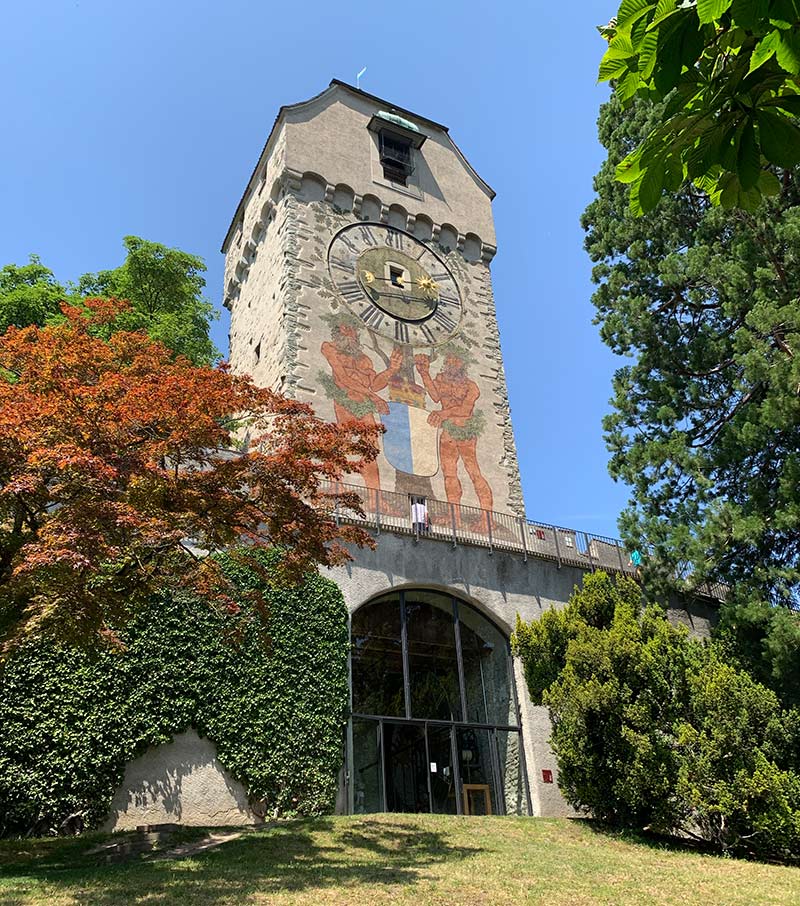
The Musegg Wall is the remains of Lucern’s old fortified city wall, dating back to 1400. Nine towers stand tall, overlooking the city and lake, and giving sight to watchmen who would sound the alarm if any invading forces got close.
Visitors have the option to tour the inside of a few of the towers along the wall. Inside the Zyt Tower, see the inner workings of an early clock that is still kept timely by a swinging stone pendulum. In others, climb very steep stone steps and peer out of arrow slits in the stone walls used by archers hundreds of years ago.
The hike to the old city wall from the city is steep, but it is well worth the views from the towers. Take some time out of your visit to Lucerne to learn more about the Swiss military history and marvel at how well preserved the Musegg Wall is after more than 600 years.
Link to map.
7. Mount Pilatus
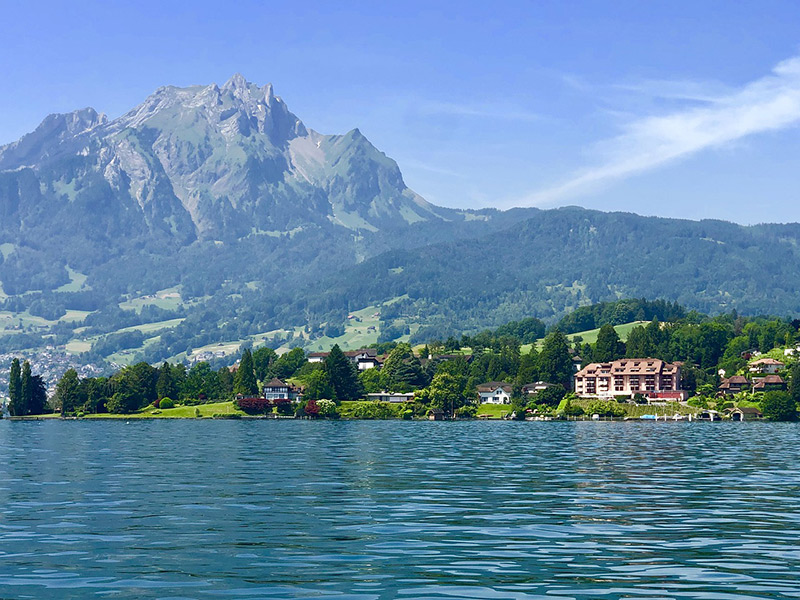
Mount Pilatus is one of the mountains overlooking Lucerne and its accompanying lake.
An old myth tells the story of a boy who was stranded on the mountain but was saved by a red dragon with the magical ability to heal people. Today, the red serpent is the logo of Mount Pilatus and is seen often during the visit.
After riding up the world’s steepest cogwheel train to the top, you emerge at Pilatus Kulm where you can enjoy a delicious meal, spectacular views, and even stay the night in a hotel and wake up to the sunrise. There are ample opportunities for hikes and wildlife spotting. A family of ibex (a member of the mountain goat family) have made Mount Pilatus their home for centuries.
Riding cable cars on the way down, guests have the option to embark on an adventure high up in the trees at the Pilatus Rope Park. Run, walk, and shimmey through 10 rope courses made for adrenaline junkies. Other high energy attractions at this stage in the journey include the longest toboggan ride in Switzerland and the Dragon Glider zipline ride.
To finish the trip, you ride down a more personal-sized cable car that allows you to watch Lucerne grow closer and closer through the glass.
Link to map.
8. Lake Lucerne Cruise
Lake Lucerne can be navigated by any of the many ships that take passengers out on its crystal blue water. The Lake Lucerne shipping company has twenty boats for almost any occasion and budget.
The ships can be fast or slow, taking you on a less than one hour loop or one that takes over three hours to complete the trip. Some tours have audio guides to give you more information about the surrounding area as you enjoy the views, others are more relaxed, letting you enjoy the food and drinks from the onboard restaurant or bistro.
More information about different ships and booking can be found here.
9. Hofkirche St. Leodegar
The Roman Catholic church dedicated to St. Leodegar is a very unique church. It is comprised of two separate and distinct styles, and that can be noticed just by looking at the front. The two towers that flank the entrance to the church are a different color of stone and not at all in the Renaissance style that makes up the central part.
The church that used to stand here dated back to the Romans, but it burned down in the 17th century. The towers remained and thus are the contrasting styles of the buildings evident.
Tall spires of St. Leodegar’s church tower above most buildings in Lucerne and can be seen from almost anywhere in the city. Take some pictures standing on the stairs leading up to the church for the best view of the unique mixed architecture.
Link to map.
10. Mount Titlis
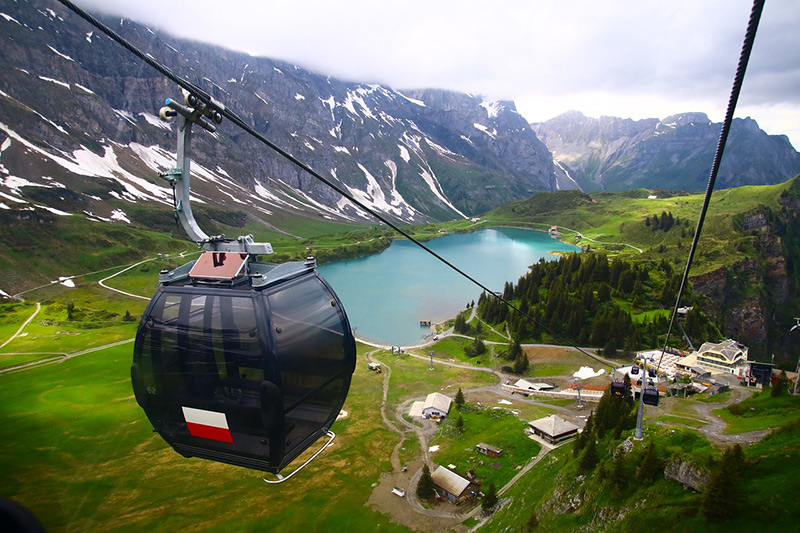
Mount Titlis is a little farther away than many of the other things to do in Lucerne, being 45 minutes to the cable station that takes visitors up to the top, but it is worth the day trip if you are looking for an escape from the city scene.
The Titlis boasts a large glacier and year-round snow near the top of the mountain which tourists can soar over in a ski lift ride called the Ice Flyer. The Ice Flyer will deposit you at the Glacier Fun Park where you can snow tube down a run specially designed to help you glide up corners and around bends.
Take a walk through 5,000 year old ice in the glacier cave. Notice frosty sculptures as you meander through the winding, slick passages.
During the summer months the glacier and snow park are open, but for those who want a less snowy mountain experience, there are many things to do on the Titlis. Go hiking, ride on the Trübsee Flyer Zipline, ride the trails on a mountain bike or scooter, pull some stunts at the Titlis Adventure Park, or go kayaking on the Trübsee Lake.
Find information on all attractions and pricing details for Mount Titlis here.
Link to map.
Map of Destinations
What to Eat in Lucerne
Here are our top 5 picks for what to eat in Lucerne:
- Restaurant Geissmatt (Italian food)
- Rated 4.5 on TripAdvisor
- Fancy sit-down restaurant with a fixed menu that changes every day. Guests get a four course meal that is decided for them. Prices are about CHF 75.- per person.
- Restaurant La Cucina (Italian food)
- Rated 4.5 on TripAdvisor
- Sit-down restaurant open for lunch and dinner. Serves Italian food in a comfortable atmosphere. Prices are about CHF 25-40 per person.
- Bolero Restaurante (Spanish food)
- Rated 4.5 on TripAdvisor
- Restaurant known for its paella, a seafood dish with meat and fish in it, and tapas, small appetizers that are self serve. There is a tapas bar where guests can get as much as they want. Prices range from CHF 12-39 per person.
- Hotel Hofgarten (Swiss food)
- Rated 4.5 on TripAdvisor
- Sit-down restaurant that serves lunch and dinner. Has indoor and outdoor seating, the courtyard has a view of the Hofkirche St. Leodegar spires. Prices are around CHF 28-40 per person.
- Nix’s (Swiss food)
- Rated 4.0 on TripAdvisor
- Sit-down restaurant that serves lunch and dinner. Has indoor and outdoor seating. Outdoor seating is right on the Reuss River with a great view of Chapel Bridge. Try the tarte flambée. Prices range from CHF 20-45 per person.
Weather in Lucerne
Here is the average Lucerne temperatures by month at a glance. Read my full guide on the weather in Lucerne, Switzerland, including the best time to visit Lucerne. (High / Low Fahrenheit)
- January – 39° / 29°
- February – 41° / 29°
- March – 52° / 35°
- April – 60° / 42°
- May – 66° / 48°
- June – 74° / 56°
- July – 77° / 59°
- August- 76° / 58°
- September – 67° / 52°
- October – 58° / 44°
- November – 47° / 36°
- December – 39° / 30°
Lucerne Webcams
Here are some of the best webcams that allow you to get a little taste at what Lucerne is like, day and night.
Travel Tips When Going to Lucerne
What currency is accepted in Lucerne?
The Swiss Franc (abbreviated CHF) is the national currency of Switzerland and is accepted in Lucerne and throughout the country. Many businesses will accept US dollars, but an exchange fee will be charged to customers who use anything but Swiss Francs.
What language is spoken in Lucerne?
In Lucerne and the surrounding area, Swiss German is the most common language. Many locals will know at least some English, so communication should not be an issue.
When is the best time of year to visit Lucerne?
From June to September is the best time to visit Lucerne if you are looking for warm weather. This is the perfect time to explore the town, go on hikes, or swim in the crystal clear lake.
From November to February expect cold weather and snow. If you are into snow sports, this is a great time to visit the mountain slopes near Lucerne to ski and snowboard.
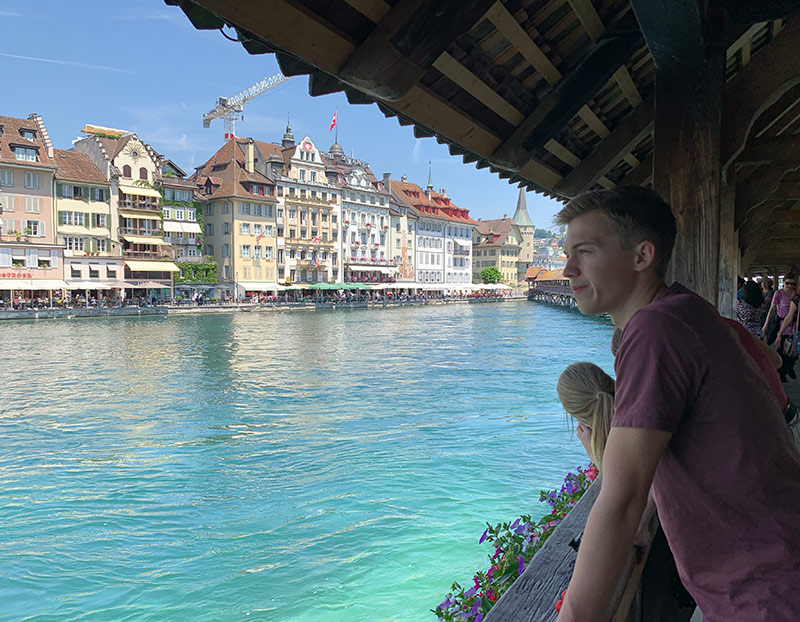
Facts and History About Lucerne
- Lake Lucerne is full of beautiful, white swans during the warm summer months. As the story goes, the swans were a gift from King Louis XIV in the 1600s because his personal guards were hired from the Swiss military and he wanted to show Switzerland his appreciation.
- Lake Lucerne is also known as the Lake of the Four Cantons because, you guessed it, there are four cantons that meet at the lake.
- What are cantons?
- Cantons are similar to states in the United States or provinces in Canada. They have their own individual governments and laws, but they ultimately answer to Switzerland as a whole.
- The water level of Lake Lucerne is controlled by Lucerne’s Needle Dam. The retractable dam can be extended as far as it needs to be in order to restrict the water flow and keep the Reuss River from flooding the villages along its banks.
- Lucerne is the capital of the Lucerne canton which covers almost 1,500 square kilometers. The Lucerne canton flag is blue and white – you’ll see it all over the city.
- In old town, each building must accommodate residential housing so life doesn’t bleed out of the city. The worry is that if buildings become completely commercial, the only people in the streets will be those who are going to work or touring. Lucerne is trying to maintain its status as a livable city by enticing its citizens to reside inside the old town.
- The medieval weapon, the Lucerne hammer, was named after this city because many of these were found at and near Lucerne. It was a popular weapon during the 1400-1600s.
- The Lucerne Music Festival takes place here every year from August to September. During the month, there are over 100 classical music concerts that take place inside the city.
Lucerne Trains
Lucerne is one of the most central cities in Switzerland because of its geographical location. Thus there are trains going in and out of the Lucerne railway station constantly to almost every major city in the country.
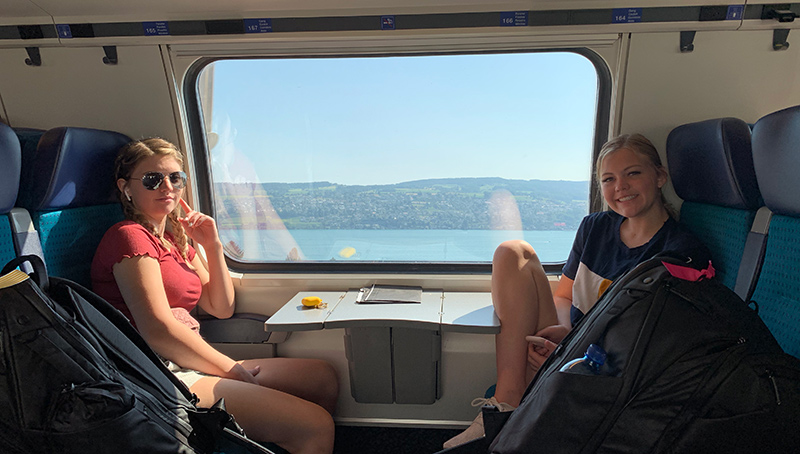
How to Save Money on Transportation in Lucerne
In the city of Lucerne, you probably won’t need to ride the train or bus in order to get around the city. However, if you want to venture out to Mount Pilatus, Mount Titlis, or anywhere else in Switzerland, you can save some money by getting a travel pass of some sort.
Here are a few options that can decrease the cost of Swiss travel:
The Swiss Travel Pass. With the Swiss Travel Pass, you will be able to use almost any public transportation in Switzerland for a consecutive 3, 4, 8, or 15 days. Along with unlimited travel to most places in the country, the trips up and down Mount Pilatus and Mount Titlis are 50% off with the Swiss Travel Pass. Some lake cruises are also covered with this pass. This travel pass also grants you free access to more than 500 museums in Switzerland. Tickets and pricing can be found here.
The Swiss Half Fare Card. For those who want to save money but don’t want to be held to fixed, consecutive days with the Swiss Travel Pass, the Half Fare Card gives you half price public transportation throughout the country. The 50% discount does apply to tickets to Pilatus and Mount Titlis as well. Tickets and pricing can be found here.
The Tell-Pass. The Tell-Pass makes it super easy to get around the Lake Lucerne region. If you are going to be around the Swiss lake for 2, 3, 4, 5, or 10 days, this pass might be the best option for you. This pass works on trains, boats, buses, and cable cars in the region including to Pilatus and the Titlis. Tickets and pricing can be found here.
How to Get to Lucerne
Specific directions to Lucerne from common cities: Zürich, Bern, Geneva, and Basel. Here is the Swiss train website to find specifics and buy tickets:
- Zürich to Lucerne (For more options and details, check out our Zürich to Lucerne Travel Guide)
- At Zurich HB, board the train in the direction of Lucerne.
- Get off at Lucerne (end of the line).
- Bern to Lucerne
- At Bern, board the train in the direction of Lucerne.
- Get off at Lucerne (end of the line).
- Geneva to Lucerne
- At Geneva, board the train in the direction of Lucerne.
- Get off at Lucerne (end of the line).
- Basel to Lucerne
- At Basel SBB, board the train in the direction of Lucerne.
- Get off at Lucerne (end of the line).
Lucerne Packing List
Lucerne is known for its unpredictable weather patterns. The summer weather can get warm, but it is also the rainy season and the temperature can become cold and rainy very quickly.
No matter what time of year you go to Lucerne, be sure to bring clothes that you can layer, even if you’re going in the middle of July, because you never know in Lucerne.
Suggested Packing List
- Comfortable walking shoes (you will be on foot a lot)
- Hiking shoes if you plan on getting out on the trails
- Socks
- Jeans and shorts so you can be warm or cool if the weather calls for it
- T-shirts, long sleeve shirts, jackets, and coat that you can layer
- Umbrella
- If you are traveling from the United States, a travel plug adapter is necessary if you want to use any of the Swiss wall outlets
Estimated Cost of Lucerne
Transportation. If you are staying inside the city, the costs of transportation will be pretty low. Everything worth seeing in Lucerne is within walking distance, but if you want to get out to the mountains or out on the lake for a cruise you will have to pay for transportation. For these excursions, expect to pay anywhere from CHF 40.- to 120.-.
Dining. Dining in Lucerne is expensive at most sit-down restaurants. Expect to pay over CHF 20.- per person for lunches and dinners here.
Hotel / Airbnb. During peak season, the prices of hotels and Airbnbs skyrocket. Expect to pay anywhere from $200-900 per night for a hotel and $100-650 per night for an Airbnb.
Breakdown of Lucerne costs:
- Transportation:
- Adults: Anywhere from CHF 40-120 per person for long round trips to Mount Pilatus and Mount Titlis
- Children with Junior Card (6-16): FREE if they are traveling with a parent and have a Junior Travelcard
- Children under the age of 6: FREE
- Meals: CHF 20-40 per person
- Hotel / Airbnb: $200-900 per night
